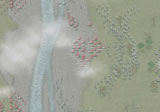 In a RTS world full of clones,
it’s nice to know that there are still times when, for the most part, original and
refreshing games can appear. The historical RTS game Takeda from Xicat Interactive charges
onto a field littered with the boxes of games that would make a troop of Elvis
impersonators proud, building a fan base not on flashy graphics and repeated game antics,
but on unique and interesting game play. With a solid atmosphere, a strong and reliable
historical basis, and a very good implementation of old-time strategies and troop warfare,
Takeda is more addictive than most games I’ve played in the last two years. Though
not without complaints, some quite numerous, and an unavoidable comparison to Shogun:
Total War, Takeda should be on your list if you’re looking for something to breath
new life into your old -- err, more modern -- view of the traditional tank dominated, unit
oriented real time strategy genre. While not perfect, Takeda is an example of how
historically oriented games, designed for accuracy and reality in gameplay, can be very
worth the average RTS gamer’s attention. I say, at least for a while, put aside the
motorized vehicles and rocket propelled weapons, and dawn instead bamboo armor and
twin-horned helmets.
In a RTS world full of clones,
it’s nice to know that there are still times when, for the most part, original and
refreshing games can appear. The historical RTS game Takeda from Xicat Interactive charges
onto a field littered with the boxes of games that would make a troop of Elvis
impersonators proud, building a fan base not on flashy graphics and repeated game antics,
but on unique and interesting game play. With a solid atmosphere, a strong and reliable
historical basis, and a very good implementation of old-time strategies and troop warfare,
Takeda is more addictive than most games I’ve played in the last two years. Though
not without complaints, some quite numerous, and an unavoidable comparison to Shogun:
Total War, Takeda should be on your list if you’re looking for something to breath
new life into your old -- err, more modern -- view of the traditional tank dominated, unit
oriented real time strategy genre. While not perfect, Takeda is an example of how
historically oriented games, designed for accuracy and reality in gameplay, can be very
worth the average RTS gamer’s attention. I say, at least for a while, put aside the
motorized vehicles and rocket propelled weapons, and dawn instead bamboo armor and
twin-horned helmets. 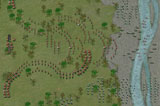 Takeda places you in charge of the Takeda family in a world
modeled after the history books, everything from the family names and locations, to the
castle designs and formations used in man’s oldest sport: War. Unlike traditional RTS
games, you have no direct control of the individual troops, instead issuing orders to your
generals, who in turn interpret them and order the men directly. Consequently, your job as
commander is not only to consider matters of numbers and high-ground positioning, but also
to attempt to understand the hundreds of independently minded men you have flooding the
battlefield. In fact, with no resource management to speak of, the morale of your men will
play as much of a role in your battle strategies as any opposing army -- if it
doesn’t, you’ll quickly find your army fleeing in mass numbers. This again
models real life, in which you wouldn’t be able to order a man blindly into all
situations and expect him to perform exactly as you tell him no matter how uncertain his
own survival.
Takeda places you in charge of the Takeda family in a world
modeled after the history books, everything from the family names and locations, to the
castle designs and formations used in man’s oldest sport: War. Unlike traditional RTS
games, you have no direct control of the individual troops, instead issuing orders to your
generals, who in turn interpret them and order the men directly. Consequently, your job as
commander is not only to consider matters of numbers and high-ground positioning, but also
to attempt to understand the hundreds of independently minded men you have flooding the
battlefield. In fact, with no resource management to speak of, the morale of your men will
play as much of a role in your battle strategies as any opposing army -- if it
doesn’t, you’ll quickly find your army fleeing in mass numbers. This again
models real life, in which you wouldn’t be able to order a man blindly into all
situations and expect him to perform exactly as you tell him no matter how uncertain his
own survival.
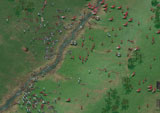 In
execution, the dedication to real life makes the game both more and less appealing in
several different ways. In the positive, I have never played a game in which tactics and
strategy play a more active role in determining a battle’s outcome than in this game.
Never before have I played a game in which my formation decisions, troop arrangements, and
attack timing -- even more so than numbers -- so totally dominated the way a battle played
out. While tricky to understand and take advantage of at first, this makes winning a
battle through your brains one of the most satisfying experiences available in the genre.
It really helps to read the crash-course on combat tactics and formations included as part
of the manual, since while it doesn't actually teach you much specifically, it really
helps to understand the details that determine a battle’s conclusion. Successfully
executing a planned battle strategy is one life’s little highlights that help us to
get up in the morning.
In
execution, the dedication to real life makes the game both more and less appealing in
several different ways. In the positive, I have never played a game in which tactics and
strategy play a more active role in determining a battle’s outcome than in this game.
Never before have I played a game in which my formation decisions, troop arrangements, and
attack timing -- even more so than numbers -- so totally dominated the way a battle played
out. While tricky to understand and take advantage of at first, this makes winning a
battle through your brains one of the most satisfying experiences available in the genre.
It really helps to read the crash-course on combat tactics and formations included as part
of the manual, since while it doesn't actually teach you much specifically, it really
helps to understand the details that determine a battle’s conclusion. Successfully
executing a planned battle strategy is one life’s little highlights that help us to
get up in the morning.
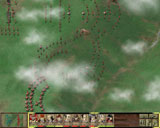 In
the negative, several design decisions made the game, at times, one of the most
frustrating I have ever played. Since units are commanded by generals, and not by you,
there is always a delay in order execution. You tell your troops to reform, march forward,
withdraw from battle, and for the most part there is little immediate indication that the
order had been received. This is realistic in that actual commanders would have to retreat
in formation, gather men, and so on, before executing any battle orders. However, this
often leaves you uncertain you’re selecting the right buttons, re-selecting and
reissuing orders repeatedly just for security sake. Additionally, the game lacks an
in-game pause feature that allows you to look over the battlefield. All decisions must be
made in the heat of the battle, while the enemy approaches. While again this is realistic,
both of these factors become annoying when one realizes that the computer is not equally
limited. The all-seeing computer enemy matches any of your own formation changes
instantly, with instant communication with all of its units. It could be argued that these
design decisions are a part of what makes Takeda unique, and while in most part I tend to
agree, small changes would have been nice. Regardless, Takeda is plagued with a number of
other technical design flaws that are simply not explainable in terms of realism. While
still enjoyable and addictive, very obvious limitations keep this game from being even
better.
In
the negative, several design decisions made the game, at times, one of the most
frustrating I have ever played. Since units are commanded by generals, and not by you,
there is always a delay in order execution. You tell your troops to reform, march forward,
withdraw from battle, and for the most part there is little immediate indication that the
order had been received. This is realistic in that actual commanders would have to retreat
in formation, gather men, and so on, before executing any battle orders. However, this
often leaves you uncertain you’re selecting the right buttons, re-selecting and
reissuing orders repeatedly just for security sake. Additionally, the game lacks an
in-game pause feature that allows you to look over the battlefield. All decisions must be
made in the heat of the battle, while the enemy approaches. While again this is realistic,
both of these factors become annoying when one realizes that the computer is not equally
limited. The all-seeing computer enemy matches any of your own formation changes
instantly, with instant communication with all of its units. It could be argued that these
design decisions are a part of what makes Takeda unique, and while in most part I tend to
agree, small changes would have been nice. Regardless, Takeda is plagued with a number of
other technical design flaws that are simply not explainable in terms of realism. While
still enjoyable and addictive, very obvious limitations keep this game from being even
better.
To start with, Takeda will only run when your computer is set to a very high
resolution, an annoying decision that left me switching between screen resolutions at the
start and finish of every game session. Menu items are almost all graphically described
with confusing icons, and the overall layout of the game is, at least at the beginning,
utterly confusing. The opening screen to the campaign mission presents you with three
buttons imposed over a map of ancient Japan. When presented with the image of a helmet,
coin, and fan (the three buttons on the map) only trial and error will reveal what each
does. The same goes for the options menu, which seems to have only minimal correlation
between the graphic you click on and the menu it takes you to.
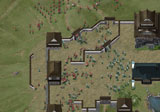 After
you become accustomed to the user interface, other complaints appear. For example, the
opening map is nearly useless. By clicking on the flags of opposing clans, you can
interpret their army’s strengths and weaknesses, and then arrange your own army
accordingly, but only if you know in advance who you are to fight. With the exception of
occasional random events, the usefulness of this ability is lost on a nearly completely
linear story line. You merely click a button to be taken to your next assignment, at which
point you are told who your new enemy is, and whisked away to the next screen. With no
back button, good luck trying to return to the map in order to analyze the enemy you now
know you are fighting. This makes sense if you are being attacked unexpectedly, but it is
ridiculous when you are launching an invasion, as the information provided can be
invaluable. I actually reloaded saves in an effort to return to the map for a little
military intelligence. Had the game been true to real life in this respect, I would have
been sending an aid to fetch both the papers from my desk, and a bagel to replace the
lunch I’d missed while in war council.
After
you become accustomed to the user interface, other complaints appear. For example, the
opening map is nearly useless. By clicking on the flags of opposing clans, you can
interpret their army’s strengths and weaknesses, and then arrange your own army
accordingly, but only if you know in advance who you are to fight. With the exception of
occasional random events, the usefulness of this ability is lost on a nearly completely
linear story line. You merely click a button to be taken to your next assignment, at which
point you are told who your new enemy is, and whisked away to the next screen. With no
back button, good luck trying to return to the map in order to analyze the enemy you now
know you are fighting. This makes sense if you are being attacked unexpectedly, but it is
ridiculous when you are launching an invasion, as the information provided can be
invaluable. I actually reloaded saves in an effort to return to the map for a little
military intelligence. Had the game been true to real life in this respect, I would have
been sending an aid to fetch both the papers from my desk, and a bagel to replace the
lunch I’d missed while in war council.
Takeda missed the boat by forcing the player into a linear story line. While this
allows for history to follow a somewhat realistic series of events, the game could have
benefited tremendously from a little Risk-style world domination. I’d have loved to
be able to choose in which direction my assault was going to be launched, testing my
skills by attacking an army larger than mine, or hiding behind an adequately safe ally.
Sadly, this sort of gameplay doesn't even make a hint of an appearance, and in my opinion,
stands as one of Takeda’s largest detractors, as it limits replayablity, and would
have prevented a repetitive feel from entering the battles.
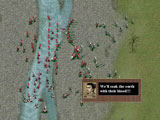 Prior
to every battle, you are taken to a screen that allows you to plan out your strategies,
choose battle formations, and assign various generals to different unit types. Though,
like the rest of the game, this screen is confusing at first, it quickly becomes an
important part of your conquest. The formations provided are numerous, fit for both
attacking and defending, but there is no ability to create your own formations. This would
have been an especially useful feature for multiplayer battles, pitting player created
formations against player created formations.
Prior
to every battle, you are taken to a screen that allows you to plan out your strategies,
choose battle formations, and assign various generals to different unit types. Though,
like the rest of the game, this screen is confusing at first, it quickly becomes an
important part of your conquest. The formations provided are numerous, fit for both
attacking and defending, but there is no ability to create your own formations. This would
have been an especially useful feature for multiplayer battles, pitting player created
formations against player created formations.
Troops come in the form of swordsmen, cavalry, spearmen, and later in the game,
riflemen. Each form of unit has advantages and disadvantages. Spearmen can stop a cavalry
charge, but will fall quickly when given the evil eye by a swordsman. Similarly, swordsmen
can fight hand-to-hand with the best of them, but can be trampled by a cavalry charge.
Overall, the makeup of the troops in your army, where they stand in formation and in what
numbers, is an important part of planning your attacking and defending strategies. This
works well, is realistic, and leads to very interesting and engaging combat - which is the
heart and soul of the game.
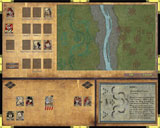 For
the most part combat is fun, forcing you to be ever resourceful, but has some distinct and
baffling absences in the feature lineup. For example, in order to select a unit, you must
click on him. The fact that he is really tiny aside, it is almost impossible to select a
moving unit, since the screen will jump to re-center whenever you miss (which you will do
two out of three times) and accidentally click on the ground beside him. So while issuing
orders to stationary formations is relatively simple, trying to redirect a battalion as it
charges to its certain doom can be very difficult, and downright frustrating. Certain
command absences are notable, too, such as a stop command for individual generals, and
specific commands for tearing down a door, or filing through a narrow area. Other commands
are included but oddly executed, one example being the "hold your ground"
command. When using the order, the computer does not assume that you want your troops to
guard the ground that they are currently on, but instead that you are going to assign them
another place to guard with the next click. This often leads to your troops moving around
at the worse possible times, such as facing a cavalry charge, when all you really wanted
them to do was stay where they were and not break ranks. The ability to assign numbers to
your generals for quick selection would have been nice as well, since it is hard to tell
which general is leading which group of troops.
For
the most part combat is fun, forcing you to be ever resourceful, but has some distinct and
baffling absences in the feature lineup. For example, in order to select a unit, you must
click on him. The fact that he is really tiny aside, it is almost impossible to select a
moving unit, since the screen will jump to re-center whenever you miss (which you will do
two out of three times) and accidentally click on the ground beside him. So while issuing
orders to stationary formations is relatively simple, trying to redirect a battalion as it
charges to its certain doom can be very difficult, and downright frustrating. Certain
command absences are notable, too, such as a stop command for individual generals, and
specific commands for tearing down a door, or filing through a narrow area. Other commands
are included but oddly executed, one example being the "hold your ground"
command. When using the order, the computer does not assume that you want your troops to
guard the ground that they are currently on, but instead that you are going to assign them
another place to guard with the next click. This often leads to your troops moving around
at the worse possible times, such as facing a cavalry charge, when all you really wanted
them to do was stay where they were and not break ranks. The ability to assign numbers to
your generals for quick selection would have been nice as well, since it is hard to tell
which general is leading which group of troops.
To sum it up, Takeda is an interesting and intriguing approach to the world of real
time strategy games, even if at times clumsily executed. While defiantly not without
flaws, and somewhat limited in its variety and re-playability, the actual combat is
addictive, fun, and provides the same rush one got when crushing a challenging enemy in a
good game of C&C back in the day. Still, the lack of political control and the
over-all repetitive style of game play keep it from a four star rating. Takeda has the
potential to appeal wildly to certain types of gamers, those who are more interested in
the logistics of strategy, but still has a solid basis for those of us who are not history
buffs. In short, it’s safe for every RTS gamer looking for a new approach to a genre
often dominated by tanks, missiles, and assault rifles. It’s easily worth a look.
